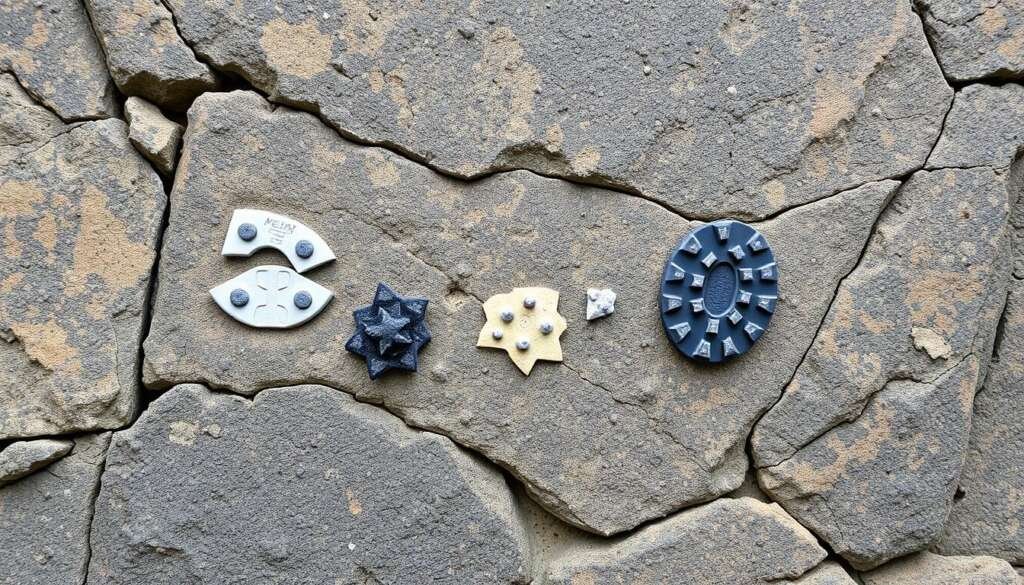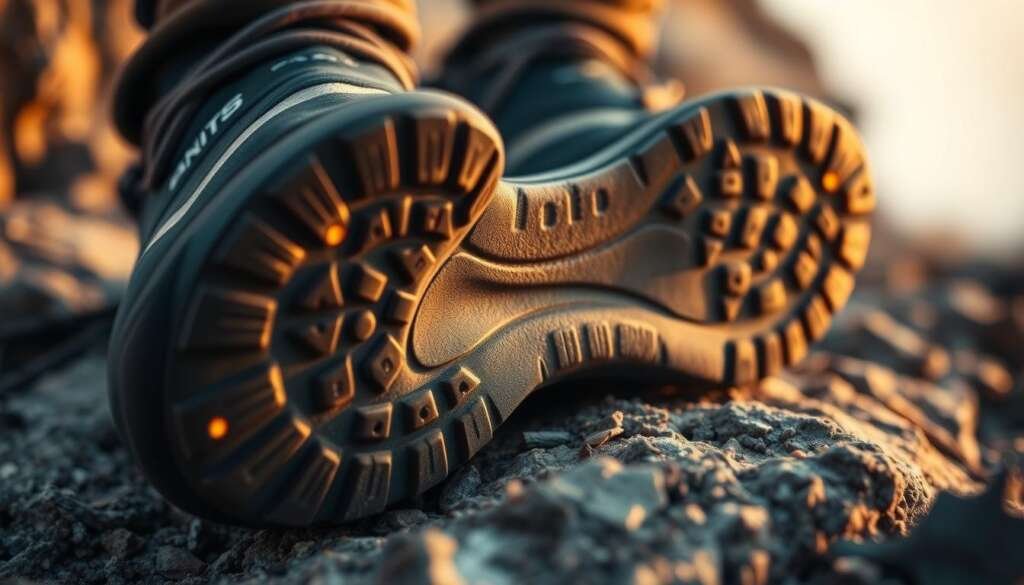Climbing shoes have evolved significantly from simple canvas footwear to highly specialized equipment designed for specific climbing disciplines. At the heart of this evolution is the intersection of physics, materials science, and biomechanics, all working together to maximize friction between the climber and the rock surface.
The design of climbing shoes focuses on increasing friction by optimizing the contact area between the shoe and the rock. This is achieved through the use of specialized rubber compounds that stick to the rock, even on small or slippery surfaces. Understanding the science behind climbing shoe design helps climbers make informed choices about their gear.
Key Takeaways
- The design of climbing shoes is a complex process involving physics, materials science, and biomechanics.
- Maximizing friction between the climber and the rock surface is crucial for climbing performance.
- Specialized rubber compounds play a key role in increasing friction.
- Understanding climbing shoe design helps climbers choose the right gear.
- The contact area between the shoe and the rock is critical for climbing performance.
Understanding Friction: The Foundation of Climbing Shoe Design
Friction is the unsung hero of climbing, providing the necessary grip between the climber’s shoes and the rock surface. It’s the key factor that determines a climber’s ability to make precise movements on the rock. Understanding friction is crucial for appreciating the intricacies of climbing shoe design.
The Physics of Friction in Climbing
In the context of climbing, friction is the force that opposes the relative motion or attempted motion between two surfaces in contact. The primary surfaces in question are the climbing shoe rubber and the rock. The physics behind friction in climbing is straightforward: the more contact between the shoe rubber and the rock, the greater the friction. This is because friction is proportional to the contact area; more contact equals more friction.
Contact Area and Its Importance
The contact area between the climbing shoe rubber and the rock surface is critical. Climbing shoe rubber is designed to be soft enough to mold to the rock’s surface, thereby increasing the contact area. This softness results in increased friction because the rubber wraps around the irregularities in the rock, enhancing the grip. Different shoe shapes and designs create varying contact patterns with the rock surface. For instance, downturned shoes concentrate contact in specific areas, while flat shoes distribute it more evenly.
The relationship between foot position, shoe design, and contact area optimization is also vital. Climbing techniques such as edging, smearing, and toe hooking utilize contact area differently. Moreover, as shoes wear out, their contact area properties change, affecting climbing performance. Thus, understanding and optimizing contact area is a primary goal of climbing shoe design.
Climbing Shoe Rubber Technology

Climbing shoes’ ability to grip various rock surfaces is significantly impacted by their rubber technology. The rubber compound used in climbing shoes is a critical factor that influences a climber’s performance on the rock.
Rubber Compounds and Their Properties
The properties of rubber compounds used in climbing shoes vary, affecting their performance on different types of rock. Soft rubber compounds tend to be stickier, providing better grip on smooth surfaces, while stiffer rubber is more durable and resistant to wear.
Softness vs. Stiffness: Finding the Balance
The debate between softness and stiffness in climbing shoe rubber revolves around the trade-offs between grip, durability, and sensitivity. Soft rubber works best for smearing on smooth or slabby rock, whereas stiff rubber is preferable for edging on small holds.
Edging vs. Smearing: Design Compromises
Climbing shoe manufacturers often make design compromises to balance edging and smearing performance. When standing on a small, flat edge, friction isn’t the deciding issue; it’s mainly a mechanical act. Thus, stiff rubber is better for edging as it won’t deform and roll off the edge. In contrast, smearing is most effective with soft rubber. Manufacturers choose a rubber compound that strikes a reasonable balance between these competing demands.
Specialized shoes for specific climbing styles may prioritize either edging or smearing performance. The shape of the shoe toe box also influences both edging precision and smearing surface area. Climbers can adapt their technique to maximize performance based on their shoe’s design priorities.
The Science Behind Climbing Shoe Design
The science behind climbing shoe design is multifaceted, incorporating elements of physics, anatomy, and materials science. Climbing shoes are not just simple footwear; they are highly specialized tools that directly impact a climber’s performance and safety.
Anatomical Considerations in Shoe Design
Anatomical considerations play a crucial role in the design of climbing shoes. The shoe must fit snugly to provide support and precision, yet not so tight that it causes discomfort or injury. The design takes into account the shape of the foot, the positioning of the toes, and the need for a secure fit that allows for optimal performance. A well-designed climbing shoe can enhance a climber’s ability to feel the rock and make precise movements.
Tension Systems and Downturned Profiles
Tension systems and downturned profiles are key features in modern climbing shoes. Tension systems, such as lacing and straps, provide a secure fit and allow for adjustments to be made during climbing. Downturned profiles, which feature a shoe that is curved downward, enable climbers to stand on small footholds and maintain balance on steep terrain. These design elements work together to enhance the climber’s ability to perform complex movements.
The Evolution of Climbing Shoe Technology
The evolution of climbing shoe technology has been marked by significant innovations. From early mountaineering boots to modern high-performance designs, climbing shoes have undergone substantial changes. Advances in materials science have enabled the development of new rubber compounds and manufacturing techniques, leading to improved performance and durability. The table below highlights some key developments in climbing shoe technology.
| Decade | Innovation | Impact |
|---|---|---|
| 1970s | Introduction of sticky rubber | Improved friction and performance on rock surfaces |
| 1990s | Advances in materials science | Development of new rubber compounds and manufacturing techniques |
| 2000s | Downturned profiles and tension systems | Enhanced performance on steep and technical terrain |
As climbing shoe technology continues to evolve, we can expect to see further improvements in design, materials, and performance. The integration of new technologies and feedback from professional climbers will drive innovation, leading to better climbing shoes for enthusiasts and professionals alike.
Temperature and Environmental Factors
Temperature fluctuations can dramatically alter the performance of climbing shoes. Climbers need to understand how to optimize their gear for various environmental conditions to achieve the best results.

Optimal Temperature Ranges for Climbing Shoes
The performance of climbing shoes is heavily influenced by temperature. Smooth rock is best climbed in temperatures on the lower end because the rubber doesn’t need to be at maximum softness to provide adequate grip. Conversely, rough rock is best climbed in warmer temperatures due to the increased softness of the rubber, which enhances friction.
Adapting Your Climbing Shoes to Weather Conditions
Climbers can employ simple tactics to adapt their shoes to different weather conditions. For instance, during winter, warming up cold and dry shoes by placing them near a heat-radiating body can improve performance. In contrast, during summer, keeping shoes in the shade or near a chilled water bottle after use can help maintain their effectiveness. Understanding these temperature adaptations can significantly enhance climbing performance.
By recognizing how environmental factors affect shoe performance, climbers can make necessary technique adjustments. Moreover, innovative products and approaches can help maintain optimal shoe performance across varying weather conditions, giving climbers a competitive edge.
Rock Types and Surface Interaction
Understanding how different rock types affect climbing shoe performance is essential for climbers. The effectiveness of climbing shoes is significantly influenced by the rock surface they interact with.
How Different Rock Types Affect Shoe Performance
The performance of climbing shoes varies across different rock types due to factors such as grain size, shape, porosity, and composition.
Grain Size and Shape
The grain size and shape of the rock surface can greatly impact the friction generated between the shoe rubber and the rock. For instance, coarse-grained rocks tend to provide more friction compared to fine-grained rocks.
Porosity and Composition
The porosity and composition of the rock also play a crucial role. Porous rocks can absorb chalk and dirt, reducing friction, while the composition (e.g., limestone, granite) affects the rock’s hardness and abrasiveness.
Choosing the Right Shoe for Specific Rock Types
Selecting the appropriate climbing shoe for the specific rock type is vital. For example, shoes with softer rubber compounds are more effective on smooth or polished rock surfaces, while stiffer rubber is better suited for rough or abrasive surfaces.
| Rock Type | Recommended Rubber Type | Friction Level |
|---|---|---|
| Smooth Rock | Softer Rubber | High |
| Rough Rock | Stiffer Rubber | Medium |
| Porous Rock | Specialized Rubber | Variable |
Maintaining Shoe Performance on Various Surfaces
To maintain optimal performance, climbers should regularly clean their shoes, especially after climbing on dirty or chalky holds. Using a damp rag to clean the soles and allowing them to air-dry can help restore friction. Additionally, recognizing when the rubber is becoming glazed or polished and using sandpaper to restore the surface can be beneficial.
- Regularly clean climbing shoes to remove dirt and chalk.
- Use a damp rag to clean the soles and allow them to air-dry.
- Restore glazed or polished rubber with sandpaper.
Conclusion: Optimizing Your Climbing Experience
Climbing shoe technology has evolved significantly, and grasping its underlying principles can enhance your climbing performance. Understanding the science behind climbing shoe design allows climbers to make informed decisions about their gear, ultimately improving their climbing experience.
The relationship between friction, rubber properties, and rock characteristics plays a crucial role in climbing shoe selection. Climbers must consider the type of rock they’ll be climbing on and choose shoes with the appropriate rubber compound to maximize friction.
To optimize your climbing experience, maintain your shoes by cleaning them regularly and using the minimum amount of chalk necessary. Remove any excess chalk from your hands before climbing, and never apply it to footholds. Additionally, keeping your skin in good condition by moisturizing and sanding as needed can improve the interaction between your skin and the rock.
By applying these principles and experimenting with different shoe types, climbers can develop a deeper understanding of how shoe design affects their personal climbing experience. As David Flanagan, a climber and writer, emphasizes, the right shoe can make all the difference. The key is finding the perfect balance for your specific needs.

